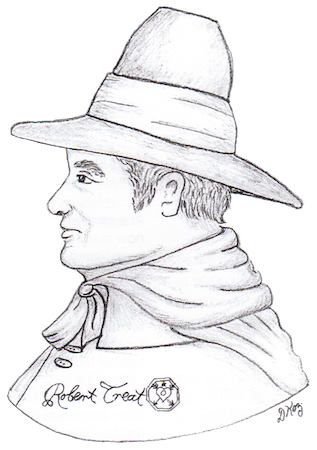Robert Treat of Milford was one of Connecticut’s great unsung heroes. Only brief sketches published in the early 20th century or before exist but Connecticut’s public records are replete with the name of Robert Treat, an early settler of Milford, deputy governor and governor of Connecticut, and officer of the colony’s military.
Fifth child of Richard and Alice (Gaylord) Treat, Robert was christened on February 25, 1625 (NS) in Pitminster, Somerset, England. Treat’s family was one of the founding settlers of Wethersfield, Connecticut’s first town.
Lambert’s History of New Haven Colony states he was Milford’s first Town Clerk from 1640 to 1648. This may be in dispute. Other sources say he arrived with Rev. Prudden from Wethersfield at age 16 or 17. That would have been after 1641 in our Gregorian (“NS”) calendar. Dating of most colonial events up until 1751 were under the Julian (OS or “Old Style”) calendar with a New Years Day of March 25 (not January 1st). Confusion in dating is often problematic. It is possible a literate young man in a society of young men could have taken the post at age 15 or 16 in 1640 (OS), or, being ambitious, he may have just overstated his age.
He was, nonetheless, a figure of influence in the nascent village including laying out much of the town as an early surveyor, acting as attorney, as an individual magistrate or as judge of local disputes in concert with other local luminaries such as Benjamin Fenn, and gaining appointment as an officer in the town militia, as lieutenant of the Train Band in 1654 and later as its captain.
He served as a deputy to the General Court at New Haven (combination legislature and court where all business of colonial government took place) in 1653 and each year thereafter until he was elected magistrate from 1659 serving until 1664 when he declined reelection due to opposition to the union of New Haven and Connecticut Colonies under the Charter of 1662. At that time great discontent prevailed over the proposed union. Milford declined to send any representatives to the General Court at all. Treat was one of the local leaders most resistant to the new government - one that would permit the unregenerate to vote in civil as well as ecclesiastical matters. In protest, he resigned as a magistrate but was lured into playing a compromising role of helping the integration of the two colonies’ governments, much to his later regret.
The religious liberalism of Connecticut Colony so rankled him that in 1667 he led a group of similarly disgruntled Milfordites, New Haven area families, and most of the populace of the Village of Branford to found a new town that he insisted also be named Milford. The equally religious flock from Branford, led by Rev. Abraham Pierson, had the named changed to “New Ark,” later, Newark, N.J. Throughout, Treat played an influential organizational, military and political role there, including that of City Clerk.
In 1672, leaving property and two sons in Newark, Treat returned to Milford just as a Dutch threat to New England waterborne commerce and rumors of a land invasion brought hasty military preparations to Connecticut and Massachusetts. Founded in 1608, “New Amsterdam” had been turned over to England in 1664 but the Dutch regained control in 1673. Connecticut and much mightier Massachusetts organized sea and land forces. Treat was commissioned a Major and appointed second in command in 1673. He formed a committee of safety.
The threat soon dissipated as English control of New York resumed in 1674, but his military prominence earned Treat appointment by the Connecticut General Assembly to commander in chief in charge of the four companies of the Connecticut colony’s forces during “King Philip’s War” of 1675. “King Philip,” seeing the threat to the Indian way of life, embarked on a war of extermination to drive out the colonists. A Wampanoag Sachem actually named Metacom, he was called “King Philip” by whites who had honored him like “Philip of Macedonia.” (His brother Wamsutta, who died in 1662, was “King Alexander”). “Kings Alexander and Philip” were, ironically, sons of Massasoit, the great sachem who had befriended the Pilgrims at Plymouth during the terrible winter of 1620 allowing the very survival of the English on this part of the continent.
“Philip” led a coalition of Indian tribes that devastated several New England settlements. Many formerly feuding Indians joined the cause (not including Wepawaugs of Milford). Treat conducted himself with military distinction, successfully fending off and defeating the Indians in several engagements including victory in the "Swamp Fight." Upon his triumphant return he was commissioned Colonel of the militia of New Haven County. The next year (1676) he was elected deputy governor and in 1683 the eighth governor making him one of the first Americans to rise from a successful military career to high political office.
Most famously, Robert Treat was governor when in the 1680s King James II attempted to consolidate his northern American colonies into the dominion of New England extending from Maine to New Jersey. He sent Sir Edmund Andros to be his governor. Andros, called the “tyrant of New England,” believed that they must, among other things, gain physical possession all the royal colonial charters. The General Court of Connecticut had formally received its royal Charter on October 9, 1662, from King Charles II mostly through the diplomacy of Gov. John Winthrop. Andros soon had all but one. Andros in Boston demanded Connecticut surrender its Charter. Governor Treat demurred and stonewalled for the better part of a year. In 1687, a frustrated Andros marched with an armed unit to the General Assembly at Hartford. Treat diplomatically presided over the discussion over a table holding the Charter well into the night. Suddenly all lights were extinguished. When relit, the Charter was gone. Captain Joseph Wadsworth is credited with secreting the Charter in the majestic “charter oak” on the Wyllys estate. Andros, returned to Boston empty-handed and thereafter Connecticut would be called the “Constitution State.”
As governor, Treat negotiated in 1683 Connecticut’s long standing western boundary with New York, giving away claims to Rye and the “Oblong” (a 1.8 mile wide swath parallel to today’s border from above Stamford at the Ridgefield bight to the Mass. border), with Connecticut retaining the “panhandle:” Greenwich and Stamford. Nevertheless, the border dispute would still fester for nearly two centuries before finally being resolved in 1879 on essentially the same terms. Treat served as governor until 1698 when local political events favored Fitz-John Winthrop. Treat continued as deputy governor until he retired in 1708 at the age of eighty-two. He died two years later on July 12, 1710. He was dutiful husband to Jane Tapp. They left many descendants, many of whom are still in the Milford area.
Few men have sustained a fairer character or rendered the public greater service. He was exceedingly beloved by his community. It was said he could often be found, Cincinnatus like, with his farmer’s hands upon the plow only to be called over to his roadside stone wall to consult or sign important papers. He was honored by contemporaries as the “beau-ideal of a gentleman.”



